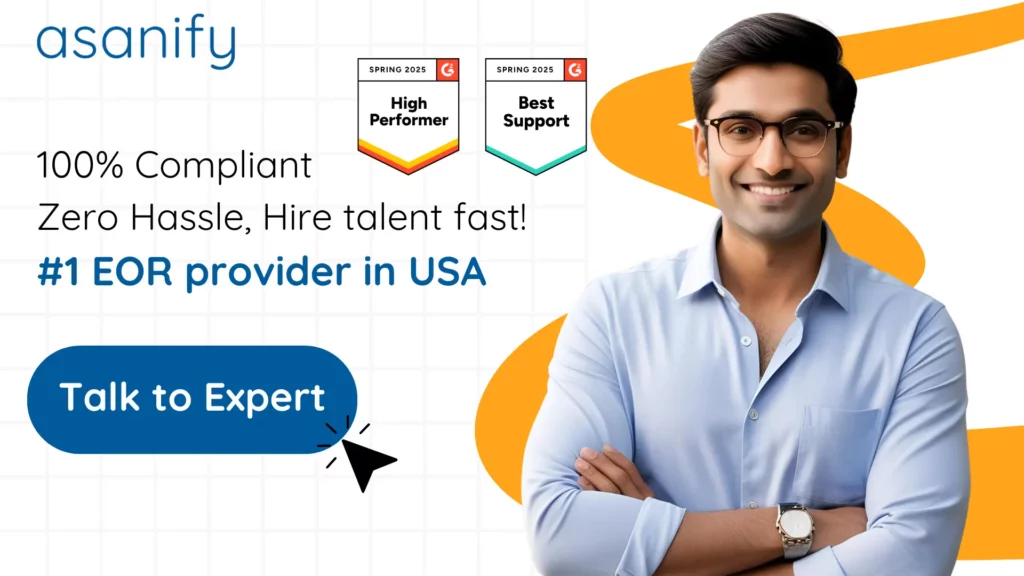Hiring remote talent in the United States offers access to a highly skilled workforce, but it also introduces a complex web of legal, tax, and compliance requirements. Whether you’re a startup scaling into the U.S. or a global enterprise looking to expand your distributed workforce, using an Employer of Record (EOR) can streamline the process. This blog provides a complete Employee Onboarding Checklist tailored to the U.S. hiring landscape through an EOR—helping you stay compliant while delivering a great experience for your new team members.
Table of Contents
- Remote Employee Onboarding Process
- Before the Job Offer Letter
- After the Job Offer Letter
- Onboarding Day
- Post-Onboarding
- Seamless Onboarding with Asanify EOR in the USA
- Conclusion
- FAQs
Remote Employee Onboarding Process
When you partner with an EOR in the U.S., onboarding becomes more structured, compliant, and efficient. The EOR ensures that all federal and state employment laws are followed, manages taxes and benefits, and handles essential HR documentation. From offer acceptance to post-hire support, the EOR onboarding process US ensures your remote team is set up for long-term success.
- EORs ensure multi-state labor law compliance from day one.
- The onboarding flow includes documentation, benefits enrollment, and HR support.
- A shared responsibility model between the EOR and client improves process clarity.
- Helps reduce misclassification risks and streamline payroll accuracy.
- Ensures faster employee readiness through pre-scheduled training and orientation.
Suggested Read: Employer of Record USA: A Detailed Guide 2025
Before the Job Offer Letter
Effective onboarding begins well before Day 1. Early alignment on role expectations, compliance requirements, and logistics ensures a smoother transition, reduces confusion, and sets the foundation for a successful working relationship.
Client Company Responsibilities
- Identify and interview qualified candidates to hire remote workers in USA.
- Finalize compensation, title, responsibilities, and remote work expectations.
- Clearly communicate role expectations, time zones, and cultural fit.
- Verify organizational policies on background checks, NDA, and security access.
- Share key details with the EOR to prepare ahead of time.
EOR Responsibilities
- Verify the candidate’s work eligibility, including citizenship or visa status.
- Advise on state-specific regulations, like local minimum wages or paid leave.
- Prepare insights on taxes, healthcare mandates, and employment classifications.
- Create a custom compliance checklist for specific U.S. states.
- Confirm mandatory employment documents for pre-boarding.

After the Job Offer Letter
Once the offer is accepted, both parties must align to ensure a seamless onboarding experience. Timely coordination around documentation, logistics, and introductions helps build trust and sets clear expectations from the start.
EOR Responsibilities
- Conduct background checks in accordance with U.S. FCRA guidelines.
- Draft an at-will compliant employment agreement outlining compensation, leave, and terms.
- Collect documents like I-9, W-4, direct deposit info, and Social Security numbers.
- Enroll the employee in benefits packages and tax deduction systems.
- Ensure compliance with EEOC, ACA, and state new hire reporting rules.
Client Company Responsibilities
- Share welcome kits, team intro docs, and access to internal platforms.
- Assign an onboarding buddy or mentor to guide the new hire.
- Coordinate with EOR for hardware delivery and account setup.
- Schedule virtual meet-and-greets with relevant teams.
- Define initial project goals, timelines, and key performance indicators.
Suggested Read: Detailed Guide to EOR vs. Entity Establishment in USA
Onboarding Day
Onboarding day is pivotal—it sets the tone for employee engagement, organizational clarity, and long-term compliance. A well-structured first day helps new hires feel welcomed, informed, and confident in their roles. It’s the foundation for productivity and retention.
EOR Responsibilities
- Ensure all documents are signed and stored securely.
- Complete I-9 verification and register the employee for payroll and taxes.
- Offer a walkthrough of the HR system and explain how to track time, benefits, and salary.
- Set up legally required notices and post-hire employee training (e.g., anti-harassment).
Client Company Responsibilities
- Host a virtual orientation session covering mission, values, and key introductions.
- Ensure access to tools like Slack, project management platforms, and email.
- Review job-specific expectations and initial deliverables.
- Provide departmental overviews and introductions to project leads.
- Establish a roadmap for performance tracking during the first 30/60/90 days.

Post-Onboarding
Great onboarding extends beyond the first week—it fosters lasting employee success and engagement. Regular check-ins, feedback, HR support, and development opportunities help remote hires feel valued, stay compliant, and align with company goals.
EOR Responsibilities
- Manage ongoing payroll, tax reporting, and healthcare deductions.
- Ensure state-specific employment law compliance is maintained.
- Serve as the HR contact for benefits, insurance claims, and employee concerns.
- File federal and state wage reports and manage leave tracking.
- Support employee satisfaction surveys and workplace engagement initiatives.
Client Company Responsibilities
- Provide regular feedback, performance reviews, and career development plans.
- Promote open communication through check-ins and peer reviews.
- Foster culture through virtual events, feedback loops, and cross-functional exposure.
- Encourage continuous learning via access to courses and mentoring programs.
- Track retention metrics to optimize future onboarding success.

Seamless Onboarding with Asanify EOR in the USA
Asanify streamlines the remote onboarding USA process with a comprehensive EOR solution, enabling businesses to hire in any U.S. state without establishing a local entity. From managing payroll, taxes, and benefits to delivering welcome kits and IT logistics, Asanify ensures fast, compliant, and seamless onboarding. It offers localized legal guidance, 24/7 support, and transparent pricing while maintaining data security and minimizing legal risks. Asanify’s scalable platform adapts as your team grows, transforming your employee onboarding checklist US from a manual task into a smooth, automated experience.
Conclusion
By using this Employee Onboarding Checklist with an EOR in the U.S., you not only ensure compliance but also create a smooth and engaging experience for your remote team. From offer to integration, this framework sets your team up for success while minimizing legal risks and administrative burdens.A clear and actionable employee onboarding checklist US is key to improving retention, productivity, and compliance across your remote workforce. Let EOR onboarding be your strategic edge in navigating the complexities of the U.S. employment landscape.
FAQs
An EOR handles payroll, taxes, benefits, and compliance so companies can legally hire without a U.S. entity.
EOR onboarding ensures legal compliance across states, while internal HR may not have multi-jurisdictional expertise.
Yes, EORs like Asanify are equipped to handle multi-state compliance.
Employment agreements, tax forms (W-4), I-9 verifications, and benefits enrollment forms.
Typically 3–7 business days, depending on document readiness.
Yes, including healthcare, dental, vision, 401(k), and more.
Federal income tax, state income tax, Social Security, and Medicare contributions.
Yes, EORs ensure contracts are state-compliant and legally binding.
Yes, with proper classification and tax documentation.
The EOR handles new state registration and compliance automatically.
EORs use legal frameworks to distinguish W-2 employees from 1099 contractors.
Yes, logistics and IT provisioning are often included.
Yes, employers can tailor welcome materials, training, and introductions.
Absolutely; EORs support various work models including in-office teams.
EORs like Asanify offer smooth offboarding and legal support for entity migration.
Not to be considered as tax, legal, financial or HR advice. Regulations change over time so please consult a lawyer, accountant or Labour Law expert for specific guidance.

